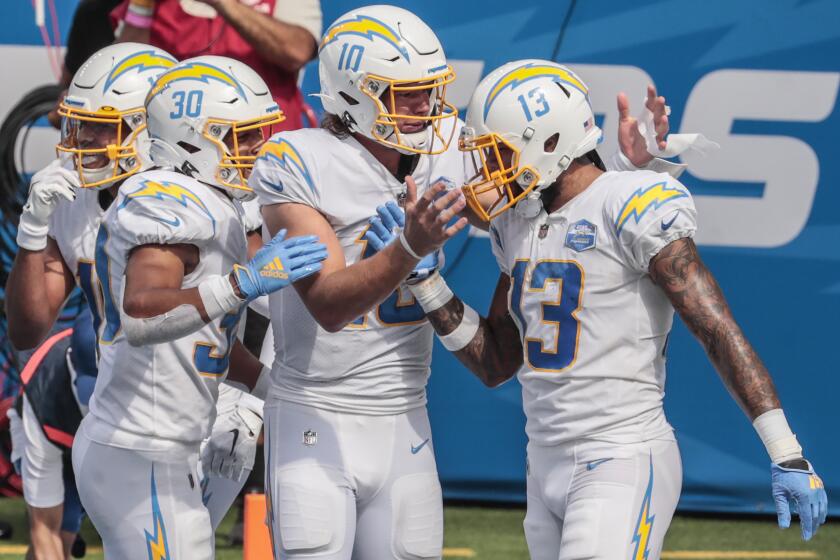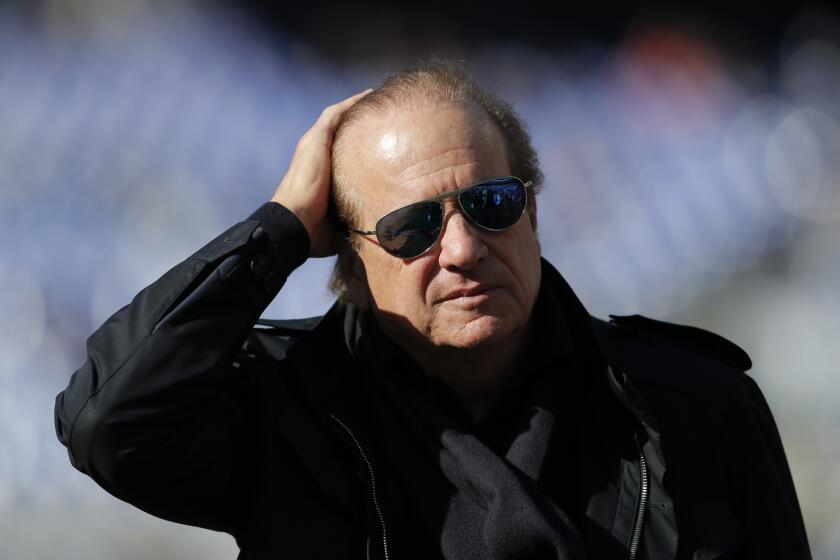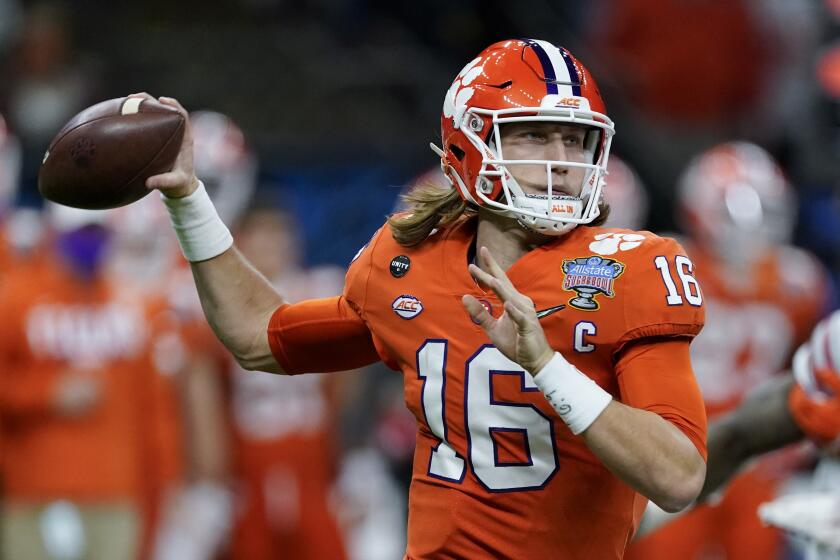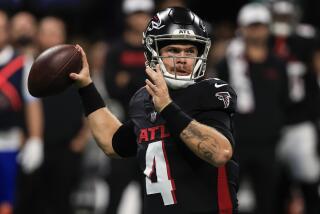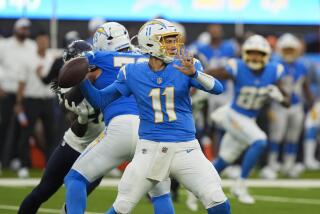Turn out lights on Forrest Lamp as Chargers continue to build offensive line
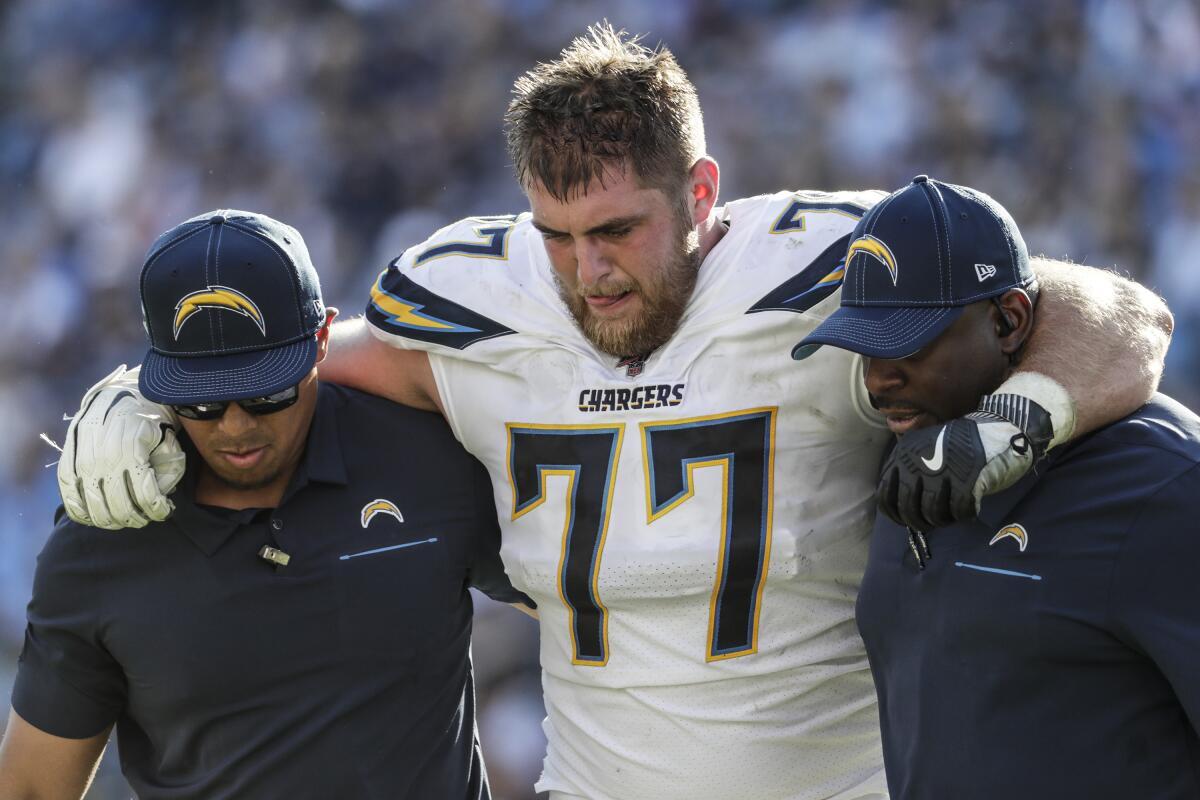
- Share via
They eagerly awaited their fate early on Day 2 of the 2017 NFL draft, the Chargers reportedly able to exhale only after the Rams dealt the No. 37 overall pick to Buffalo.
“When that trade happened,” then-coach Anthony Lynn told The Los Angeles Times, “we knew we had our guy.”
Said general manager Tom Telesco, “We basically just sat there and sweat it out — and got him.”
Their guy was Forrest Lamp, an athletic offensive lineman out of Western Kentucky, the No. 1-ranked guard that year by Mel Kiper.
“Simply put,” gushed Sports Illustrated, “Forrest Lamp is one of the best athletes in this lineman class.”
Chargers are still looking for a starting left offensive tackle, a starting cornerback and depth along both lines. All this as the Spanos family quarrels over selling team.
The publication compared Lamp to Joe Thuney, who recently signed a five-year contract with Kansas City worth up to $80 million.
On Wednesday, after four injury-filled seasons with the Chargers, Lamp officially departed by agreeing to a one-year free-agent deal with Buffalo. He’s expected to compete for a backup job.
In three weeks, the Chargers will draft their next highly anticipated offensive lineman, perhaps at No. 13 overall.
And, while picking in the top half of the first round is much different than selecting early in Round 2, Lamp’s tenure with the Chargers is a timely reminder that nothing is certain in the NFL draft.
Lamp was supposed to be an offensive building block for the Chargers. The NFL’s website called him “an excellent value pick.” Bleacher Report said Lamp would be “an immediate starter” and graded his selection as an “A.”
Instead, Lamp sustained a significant knee injury that dashed his rookie season and then spent 2018 as a reserve who couldn’t break into the starting lineup as the Chargers’ offensive line gained chemistry en route to the playoffs.
Lamp appeared in just seven games — with two starts — in 2019 before suffering another season-ending injury, a broken fibula.
Finally, last year, he took over as the Chargers’ starting left guard and never missed a snap.
And, now, he’s a Buffalo Bill.
A legal filing by Dea Spanos Berberian seeking to force the sale of the Chargers cites $353 million in family trust debt.
Lucky pick 13?
The Chargers taking an offensive lineman at No. 13 later this month is no sure thing; they also need a starting cornerback.
Daniel Jeremiah has emerged in recent years as a much-respected draft analyst. He also does radio for the Chargers, and his latest mock has them selecting South Carolina corner Jaycee Horn in the first round. But if the Chargers do go with an offensive lineman, the decision should feel somewhat historic.
Lamp and first-rounder D.J. Fluker are the franchise’s highest-picked offensive linemen going back to 1989, when center Courtney Hall was a second-round selection at No. 37 overall.
The Chargers have drafted only six offensive linemen all-time in the first round: Fluker (No. 11 overall in 2013), James FitzPatrick (No. 13 in 1986), Jim Lachey (No. 12 in 1985), Bob Rush (No. 24 in 1977), Russ Washington (No. 4 in 1968) and Walt Sweeney (No. 2 in 1963).
At arm’s length
One of the biggest knocks against Lamp during the draft process was his arm length, which measured at 32¼ inches at the combine. Because of that limitation, he projected — correctly — as an NFL guard after playing left tackle in college.
The quarrel within the Spanos family doesn’t help the Chargers’ standing in Los Angeles and could lead to a sale down the road.
Among the top offensive lineman this year, arm length has been a reference point in particular for Oregon’s Penei Sewell (33¼ inches), Northwestern’s Rashawn Slater (33 inches) and USC’s Alijah Vera-Tucker (32 1/8 inches).
As for how much the measurements matter, consider this: At the 2017 combine, Lamp was fourth among all offensive lineman in 40-yard dash (5.00 seconds), second in bench reps (34), tied for third in board jump (111 inches) and fifth in three-cone drill (7.55 seconds).
Fluker fluke
After he was selected in 2013, Fluker said he wanted to be the “Ray Lewis of my offensive line. I’m a guy that’s going to lead my team to victory.” Coming out of Alabama, he had won a pair of national titles.
Telesco praised Fluker for his energy and love of football. He called him “one of our cornerstones moving forward.”
Fluker started at right tackle as a rookie and played well before his production began to slip. He eventually was moved to right guard and spent four years with the Chargers before leaving via free agency in 2017.
The Jacksonville Jaguars are widely expected to select Clemson’s Trevor Lawrence with the No. 1 pick, but who will the Jets and 49ers select next?
O-line picks
The Chargers have received little long-term production from the offensive linemen they’ve drafted. Here are their selections up front over the past decade:
2019: Tackle Trey Pipkins, third round, No. 91 overall.
2018: Center Scott Quessenberry, fifth round, No. 155.
2017: Lamp, second round, No. 38; guard Dan Feeney, third round, No. 71; tackle Sam Tevi, sixth round, No. 190.
2016: Center Max Tuerk, third round, No. 66; guard Donavon Clark, seventh round, No. 224.
2014: Guard Chris Watt, third round, No. 89.
2013: Fluker, first round, No. 11.
2012: Guard Johnnie Troutman, fifth round, No. 149; center David Molk, No. 226.
2011: Guard Stephen Schilling, sixth round, No. 201.
More to Read
Go beyond the scoreboard
Get the latest on L.A.'s teams in the daily Sports Report newsletter.
You may occasionally receive promotional content from the Los Angeles Times.

